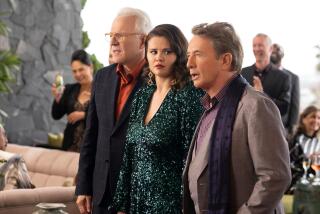Crime and Punishment Never Looked So Good
Are these the best of times, the worst of times or something hum-drum in between? When you look around, do you see any golden ages?
Hardly. This is not the golden age of race relations. Not the golden age of Yugoslavia. Not the golden age of smallness. Not the golden age of Canadian togetherness. Not the golden age of English grammar (too many people “laying” down instead of lying down). Not the golden age of newspapering. Not the golden age of newscasting. Not the golden age of daytime talk shows. Not the golden age of anything on television . . . with one exception.
It is TV’s golden age of crime drama.
At no other time has there been as many quality crime series in prime time. The present Fab Four are NBC’s “Law & Order” and “Homicide: Life on the Street” and ABC’s “NYPD Blue” and “Murder One,” in its first season.
Each is outstanding.
Three of the four have you watching largely because of their magnetic male characters. Andre Braugher’s intense Detective Frank Pembleton provides much of the charisma that drives “Homicide.” On “NYPD Blue” it’s a pair of detectives, Bobby Simone and Andy Sipowicz, played by Jimmy Smits and Dennis Franz. On “Murder One,” which is boldly clinging to one case through the season, it’s Daniel Benzali’s smoldering defense attorney, Teddy Hoffman, who dominates--although every time Stanley Tucci smirks on the screen as suspicious business tycoon Richard Cross, you feel yourself tensing up.
Less character-driven is “Law & Order,” even though Jerry Orbach’s ever-bemused Detective Lennie Briscoe, Sam Waterston’s laser-focused prosecutor Jack McCoy and Steven Hill’s wearily pragmatic D.A. Adam Schiff are interesting characters who at times lower their masks. As did Jill Hennessy’s assistant D.A. Claire Kincaid recently when her clash with McCoy over capital punishment turned out to be the point of the entire hour.
It was an example of how “Law & Order” somehow stays smart while stressing speed and crispness, accelerating investigations and trials, making them almost snag-free, while also finding time to ruminate about larger issues.
Columns like this inevitably bring “Hey, bum, you left out . . . “ letters. For example, what about earlier eras when cops, private eyes and criminal lawyers were the bison herds that roamed TV? It’s true that when it comes to sheer volume, the 1995-96 season is lean for crime series compared to earlier decades. That fine cop anthology “Police Story,” for example, made its 1973 debut on NBC amid a dozen other crime series, a panoramic “Million Man March” compared to today’s thinner field. However, even though some of these ‘70s series (such as “Hawaii Five-O,” “Kojak” and “Streets of San Francisco”) gave their large followings nice moments from time to time, none came close to equaling the superb best of “Police Story,” which so artfully probed the human element behind the thin blue line.
That 1980s classic, NBC’s “Hill Street Blues,” also stood heads taller than other crime series of its era, even though two of them, “Cagney & Lacey” and “Magnum P.I.” on CBS, were well above average, as was NBC’s “Miami Vice” when it came to dolling up gore and extreme violence in mood and style.
Two other members of the antique elite, ABC’s “Naked City” (1958-63) and “NYPD” (1967-69)--while noted for their urban, street-level realism--also occupied penthouses far above their many crime brethren.
In contrast, the present penthouse is overflowing, although for how long remains to be seen, given that “Murder One” is being disemboweled in the ratings by NBC’s “ER,” and that the tepidly supported “Homicide” barely eeked its way back for a fourth season. If putting on a great show counts, both deserve longevity.
As soon as you see “Homicide’s” stylish opening credits--the fuzzy, black-and-white, dream-like sequences of Baltimore with honking voices in the background--you anticipate something distinctive. And you get it, from grainy texture and jump cutting to a fluid, encircling camera that seems almost to waltz with actors.
Even so, its first three episodes this season hint that “Homicide” may not be quite the series it was. For example, there is newcomer Reed Diamond, who plays a hotshot arson detective who last week got bumped up to homicide. Is it a coincidence, given the networks’ emphasis on young demographics this season, that he looks like he’s on loan from “Friends”? And because of that, that he’s nearly everywhere in early episodes, tangling with Pembleton and cracking an arson case with an interrogation too swift and fortuitous to be believed?
Contrast that with a “Homicide” of two seasons ago--one of the best hours of series drama ever--when Pembleton and his partner, Kyle Secor’s Detective Tim Bayliss, grilled a murder suspect without success for 24 hours. And that’s the way it ended.
That episode symbolizes the common denominators linking “Homicide” with others of the Fab Four: superior writing and acting. Even though off form, and minus departed Daniel Baldwin and Ned Beatty, this season’s “Homicide” in spots is something to remember: A boy who dies in a fire set by an arsonist--”Bag him!” someone said--is again incinerated via cremation. Or Pembleton wondering if he and his pregnant wife are doing the right thing in bringing a child into the grim world of crime that frustrates and desensitizes him. Or Yaphet Kotto’s stressed Lt. Al Giardello tonight blindly raging at a local TV cameraman whose only sin is wanting to give cops a videotape that could break a murder case.
“Homicide” performances still sizzle (despite being Emmy-snubbed, Braugher may be the most kinetic actor on TV). And its cop characters--from the complex Pembleton to Richard Belzer’s breezy Detective John Munch to Isabella Hofmann’s Capt. Megan Russert--are as intriguing as ever. The squad room even has one detective, high-achieving Kay Howard (played by Melissa Leo), who looks like Janis Joplin.
The Fab Four are something to sing about. As for the others, bag ‘em.
* “Homicide: Life on the Street” airs Fridays at 10 p.m. on NBC (Channel 4). “NYPD Blue” airs Tuesdays at 10 p.m. on ABC (Channels 7 and 3). “Law & Order” airs Wednesdays at 10 p.m. on NBC. “Murder One” airs Thursdays at 10 p.m. on ABC.
More to Read
The complete guide to home viewing
Get Screen Gab for everything about the TV shows and streaming movies everyone’s talking about.
You may occasionally receive promotional content from the Los Angeles Times.






